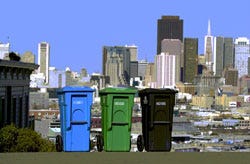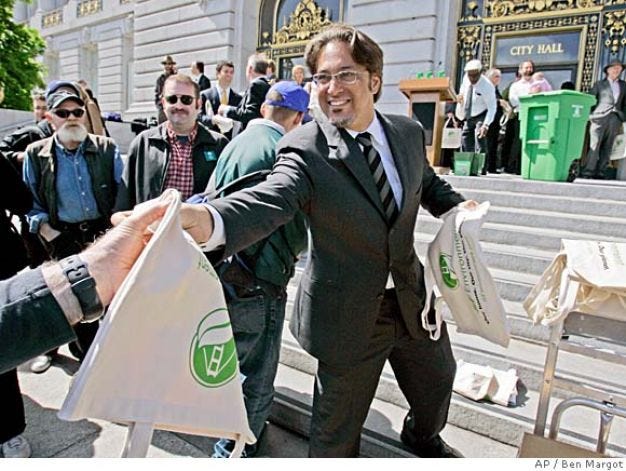Can San Francisco's end-of-life waste model work elsewhere?
The Atlantic recently published an interesting article that went behind the scenes with San Francisco's "first-of-its-kind" trash monitoring and neighborhood outreach program. Part of the crew's job, according to the article, is to track waste and ensure that citizens are throwing the trash in the correct bin. The city's residents are required by law to separate their waste into three colored bins - compost, recycling and landfill.
April 5, 2013
The Atlantic recently published an interesting article that went behind the scenes with San Francisco's "first-of-its-kind" trash monitoring and neighborhood outreach program. Part of the crew's job, according to the article, is to track waste and ensure that citizens are throwing the trash in the correct bin. The city's residents are required by law to separate their waste into three colored bins - compost, recycling and landfill.
It's a fascinating behind-the-scenes article of a "dirty" job that people probably don't ever think about or perhaps even knew existed. For instance, the article described how one of the workers shook their head in frustration when they found a citizen had thrown away a piece of plastic packaging in the landfill bin, instead of placing it in the recycling bin, which helped paint an image of this job's day-to-day tasks.
 San Francisco's diversion rate is nothing short of impressive. Last October, the city announced it had achieved 80% landfill diversion, which set national recycling and compost rate records as the highest of any city in North America. San Francisco credits this high number to its robust source reduction, reuse, and recycling and composting programs.
San Francisco's diversion rate is nothing short of impressive. Last October, the city announced it had achieved 80% landfill diversion, which set national recycling and compost rate records as the highest of any city in North America. San Francisco credits this high number to its robust source reduction, reuse, and recycling and composting programs.
While landfill disposal is at the lowest level on record and has been reduced by half over the last decade, San Francisco still sends 444,000 tons of material to the landfill each year, which is enough to fill the TransAmerica building nine times, the city said. Half of that material could be recycled or composted and actually belongs in the blue and green bins.
The city has a goal in place of zero-waste to landfill by 2020, which if it happens, would make it the first city in America to accomplish that goal.
In the news release about this diversion rate, the city quoted the U.S. Environmental Protection Agency as saying recycling creates ten times as many jobs as sending material to landfill. According to the More Jobs Less Pollution: Growing the Recycling Economy in the US Study from Blue Green Alliance, if all cities in the United States recycled and composted like San Francisco it would create 2.3 million jobs.
Still, it's hard to ignore that San Francisco has banned plastic bags and prohibits any establishment that serves food  prepared in San Francisco from using polystyrene foam. The city is also looking into reducing the usage of plastic bottled water, but as of now there isn't talk of an outright ban.
prepared in San Francisco from using polystyrene foam. The city is also looking into reducing the usage of plastic bottled water, but as of now there isn't talk of an outright ban.
San Francisco's end-of-life model is a significant topic for those in plastic packaging. The city exhibits extremely impressive diversion rates, but at the same time, has also restricted or banned products that many plastic packaging manufacturers produce.
So there are a couple thoughts to ponder here:
First, did the bans and restrictions help the city achieve this high diversion rate?
Second, instead of banning products, why not place a greater focus on recycling? For example, there is a common misconception that PS foam is not recyclable, when in fact; it is recyclable with the right infrastructure in place.
Third, can other cities duplicate San Francisco's diversion rate? And if they do, would they model themselves exactly like the city (enforcing mandatory recycling and composting, bans, restrictions, etc.). Or is there another approach to take?
It's something to think about.
About the Author(s)
You May Also Like


